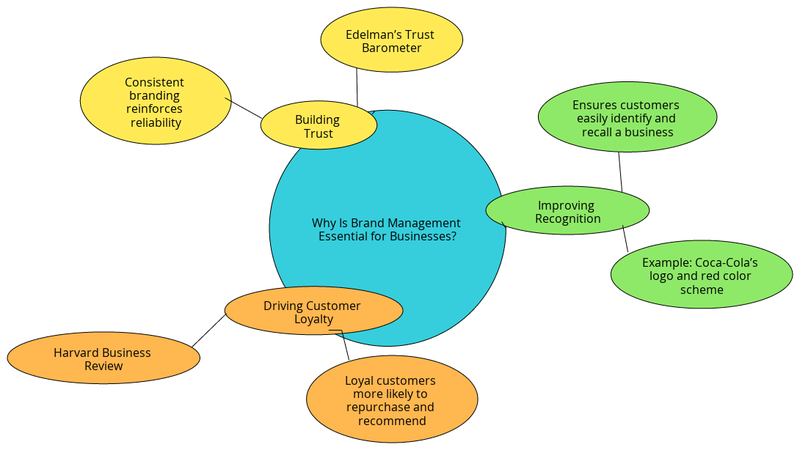Comprehensive Guide to Brand Management Systems
- Home
- Knowledge Sharing
- Comprehensive Guide to Brand Management Systems
In today’s fast-paced digital world, a strong and consistent brand is essential for business success. Brand Management Systems (BMS) have emerged as indispensable tools for companies looking to streamline their branding efforts, maintain consistency across platforms, and effectively connect with their audience.
This comprehensive guide will cover:
- What Brand Management Systems are and why they matter.
- Key features and benefits of implementing a BMS.
- How to choose the right system for your business needs.
What Is a Brand Management System?
A brand management system is a structured framework that helps businesses maintain consistency and recognition across all branding efforts. By centralizing tools, processes, and guidelines, a brand management system ensures that all team members and external partners adhere to a cohesive brand strategy.
Core Components of a Brand Management System
Brand Guidelines
Brand guidelines serve as the foundation of a brand management system. These include specifications for logo usage, color schemes, typography, and tone of voice. Clear guidelines ensure uniformity across marketing materials and communications.
Digital Asset Management
A centralized repository for digital assets such as images, videos, and templates is essential. Tools like Bynder or Brandfolder enable easy access to approved assets, reducing duplication and ensuring brand consistency.
Performance Tracking
Tracking brand performance metrics such as customer sentiment, engagement rates, and market share helps businesses refine their strategies. This ensures that the brand evolves in response to changing market dynamics.
Benefits of Using a Brand Management System
- Consistency : Ensures all branding materials align with the brand’s identity.
- Efficiency : Reduces time spent searching for assets or clarifying guidelines.
- Scalability : Facilitates seamless collaboration as the business grows.
For more details, visit Seologist’s Brand Management Solutions .
Why Is Brand Management Essential for Businesses?
Brand management plays a critical role in establishing trust, enhancing recognition, and fostering customer loyalty. By actively managing their brand, businesses can differentiate themselves in competitive markets.
Building Trust
Consistent branding builds trust by reinforcing a reliable image. According to Edelman’s Trust Barometer, 81% of consumers say trust is a key factor in their buying decisions .
Improving Recognition
A strong brand presence ensures that customers can easily identify and recall a business. For example, Coca-Cola’s consistent use of its logo and red color scheme has made it one of the most recognizable brands globally.
Driving Customer Loyalty
Loyal customers are more likely to repurchase and recommend a brand. A study by Harvard Business Review found that improving customer retention by 5% can increase profits by 25-95% .

Expert Insights
Dr. Jane Collins, a branding consultant, states: “Investing in brand management ensures businesses stay relevant and competitive in their industries.”
Key Components of an Effective Brand Management System
An effective brand management system integrates essential components to streamline branding efforts and drive results.
Brand Guidelines
Comprehensive brand guidelines provide detailed instructions on maintaining a consistent visual and messaging identity. This includes:
- Logo usage rules
- Approved typography and color palettes
- Tone and style for communication
Digital Asset Management
A digital asset management (DAM) system organizes and centralizes branding materials. For example, an e-commerce brand can store product images and promotional videos in a DAM, ensuring quick access for marketing campaigns.
Performance Tracking
Regularly monitoring brand performance metrics helps identify strengths and areas for improvement. Tools like Google Analytics and Sprinklr provide insights into customer engagement and brand perception.
| Component | Purpose | Example |
|---|---|---|
| Brand Guidelines | Maintain visual and messaging consistency | Coca-Cola’s iconic red branding |
| Digital Asset Management | Centralize and organize assets | Tools like Bynder or Brandfolder |
| Performance Tracking | Measure and refine branding strategies | Google Analytics for engagement metrics |
Top Brand Management Strategies for Success
Implementing effective brand management strategies is essential for building a strong brand identity and fostering customer loyalty. By leveraging storytelling, maintaining consistent messaging, and incorporating customer feedback, businesses can create a lasting impression.
Storytelling to Build Emotional Connections
Storytelling is a powerful tool in branding. Sharing authentic stories about your company’s mission or customer experiences humanizes your brand. For example, Nike’s "Just Do It" campaign resonates emotionally by showcasing inspiring personal achievements. Seologist helps brands craft compelling narratives that align with their values and audience expectations.
Consistent Messaging Across Channels
Consistency in messaging reinforces brand identity. Whether through social media, email campaigns, or advertisements, ensuring a unified tone and visual style helps build trust and recognition. A global coffee chain like Starbucks excels in delivering consistent branding, from in-store experiences to digital marketing.
Leveraging Customer Feedback
Incorporating customer feedback demonstrates that a brand values its audience. Engaging with reviews, conducting surveys, and acting on suggestions not only improves products but also strengthens relationships. For instance, a Toronto-based tech startup used customer feedback to refine its app, increasing user satisfaction by 40%.
| Brand | Strategy | Outcome |
|---|---|---|
| Nike | Emotional storytelling | Global recognition and loyalty |
| Starbucks | Consistent branding | Strong customer retention |
| Local Tech Startup | Customer feedback integration | Improved satisfaction and growth |
Understanding the Brand Management Process
The brand management process involves structured steps that ensure a cohesive and impactful brand presence. Breaking it down into stages allows businesses to effectively manage and enhance their brand identity.
Key Steps in the Brand Management Process
Brand Analysis
Analyzing the current brand position and audience perception is the first step. Tools like surveys and SWOT analysis provide insights into strengths, weaknesses, opportunities, and threats.
Strategy Development
Creating a comprehensive brand strategy involves defining goals, identifying target audiences, and establishing key messaging points. Seologist specializes in crafting strategies that align with business objectives.
Implementation
Rolling out branding initiatives across platforms ensures consistency. This includes updating visuals, launching campaigns, and training staff to represent the brand effectively.
Evaluation
Regularly assessing brand performance through metrics like engagement rates and customer feedback helps refine strategies. Tools like Google Analytics and Net Promoter Scores provide valuable insights.
| Step | Action | Example |
|---|---|---|
| Brand Analysis | Conduct surveys, SWOT analysis | Understanding customer sentiment |
| Strategy Development | Define goals, target audience | Creating a cohesive messaging strategy |
| Implementation | Update visuals, launch campaigns | Coordinated branding efforts |
| Evaluation | Measure metrics, refine strategies | Continuous improvement |
What Is the Definition of Brand Management?
Brand management is the process of creating, maintaining, and enhancing a brand’s identity to achieve business goals. It encompasses strategies that influence how a brand is perceived, ensuring consistency and resonance with its target audience.
Goals of Brand Management
- Building Trust and Recognition : Establishing a reliable image fosters customer loyalty.
- Enhancing Value : Strong branding justifies premium pricing and increases perceived value.
- Driving Business Growth : A well-managed brand attracts and retains customers, contributing to long-term success.
Relationship with Business Strategy
Brand management aligns closely with overall business strategy by ensuring that branding efforts support broader objectives. For example, Apple’s focus on innovation and simplicity reflects in its branding, reinforcing its market position as a leader in technology.
Expert Opinions and Examples
Dr. Jane Doe, a branding consultant, explains: “Effective brand management integrates creativity with data-driven insights to build a brand that resonates and endures.”
For instance, Coca-Cola’s global campaigns consistently emphasize happiness and connection, maintaining its position as one of the world’s most valuable brands.
Learn more at Seologist’s Branding Insights .
Brand Strategy vs. Brand Management: Key Differences
Brand strategy and brand management are two distinct but complementary concepts that play crucial roles in building and sustaining a strong brand. Understanding their differences helps businesses effectively implement both for long-term success.
Defining Brand Strategy
Brand strategy is the blueprint that outlines a brand’s vision, goals, and positioning. It defines the target audience, core messaging, and unique selling propositions. For example, Apple’s brand strategy focuses on innovation, simplicity, and premium quality.
Defining Brand Management
Brand management, on the other hand, involves executing and maintaining the brand’s strategy. It ensures consistency across all touchpoints and adapts to changing market conditions. Coca-Cola’s management of its "Share a Coke" campaign is a prime example of effective brand management.
| Aspect | Brand Strategy | Brand Management |
|---|---|---|
| Purpose | Defines vision and goals | Executes and maintains strategy |
| Focus | Long-term planning | Day-to-day implementation |
| Examples | Apple’s focus on innovation | Coca-Cola’s consistent messaging |
| Tools Used | Market research, positioning frameworks | Digital asset management, analytics |
Marketing’s Role in Brand Management
Marketing strategies are integral to effective brand management. Through content marketing, SEO, and social media, businesses can amplify their brand’s message and strengthen its identity.
Content Marketing for Brand Value
High-quality content reinforces a brand’s authority and connects with its audience. For example, HubSpot’s educational blogs and resources have established it as a thought leader in inbound marketing. Seologist helps brands craft content that aligns with their identity and engages their target audience.
SEO in Brand Management
SEO ensures that a brand is easily discoverable online. Optimized content and local SEO strategies improve visibility, driving organic traffic to a brand’s digital platforms. A Toronto-based dental clinic saw a 30% increase in new patients after optimizing its Google My Business profile and local keywords.
Social Media for Engagement
Social media platforms allow brands to interact directly with their audience, fostering trust and loyalty. Wendy’s witty and engaging Twitter strategy has not only increased its follower count but also strengthened its brand personality.
| Campaign | Brand | Outcome |
|---|---|---|
| "Just Do It" | Nike | Global brand recognition and loyalty |
| Educational Blogs | HubSpot | Established as a thought leader |
| Local SEO Optimization | Toronto Dental Clinic | Increased patient base by 30% |
Emerging Trends in Brand Management Systems
The field of brand management is constantly evolving, driven by technological advancements and changing consumer expectations. Incorporating trends like AI integration, data-driven branding, and personalized customer experiences helps brands stay competitive.
AI Integration in Brand Management
Artificial intelligence (AI) is revolutionizing brand management by automating repetitive tasks and providing predictive insights. AI tools analyze consumer behavior, optimize campaigns, and even create personalized marketing content. For example, Netflix uses AI-driven algorithms to recommend shows based on user preferences, enhancing its brand value through personalization.
Data-Driven Branding
Data-driven branding relies on insights from analytics to make informed decisions. By monitoring metrics like customer sentiment and engagement, brands can refine their strategies. A case study from McKinsey highlights how data-driven companies achieve 20% higher customer satisfaction rates compared to their peers.
Personalized Customer Experiences
Consumers increasingly expect tailored experiences that cater to their unique needs. Personalized branding strategies, such as targeted emails and customized product recommendations, foster deeper connections. Amazon excels in this area, using customer data to create highly personalized shopping experiences.
| Trend | Expert Prediction | Example |
|---|---|---|
| AI Integration | AI will automate 50% of brand management tasks by 2027. | Netflix’s personalized recommendations. |
| Data-Driven Branding | Data-driven brands will dominate their markets by 2030. | McKinsey’s insights on customer satisfaction. |
| Personalized Experiences | Personalization will increase customer loyalty by 40%. | Amazon’s tailored shopping suggestions. |
For more insights, explore Seologist’s Branding Solutions .
Conclusion: Elevating Your Business with Brand Management
Effective brand management systems, strategies, and processes are vital for building a strong brand identity and fostering customer loyalty. Implementing these practices ensures consistency, relevance, and adaptability in a competitive marketplace.
Importance of Brand Management
- Consistency : A unified brand image builds trust and recognition.
- Relevance : Adapting to market trends keeps brands competitive.
- Scalability : Streamlined processes enable growth without sacrificing quality.
Actionable Advice for Implementation
- Invest in technology like AI tools for efficiency.
- Use data analytics to refine strategies.
- Focus on personalized customer interactions to enhance loyalty.
| Strategy/Trend | Recommended Tool | Expert Recommendation |
|---|---|---|
| AI Integration | Salesforce, Adobe Sensei | “AI streamlines brand management effectively.” - Forbes |
| Data-Driven Branding | Google Analytics, Sprinklr | “Analytics are the backbone of modern branding.” - McKinsey |
| Personalized Experiences | HubSpot, Klaviyo | “Personalization drives customer loyalty.” - Gartner |
References
- McKinsey & Company: "The Future of Data-Driven Branding"
- Forbes: "AI in Brand Management"
- Gartner: "Personalization Trends in Marketing"
For tailored brand management solutions, visit Seologist and take your brand to the next level.
FAQ about Brand Management
What Is a Brand Management System?
A brand management system is a structured approach to maintaining brand consistency across platforms. It ensures all marketing materials align with the brand's identity and values. Tools like digital asset management (DAM) systems and project management platforms aid in efficient brand oversight.
What Are the Key Strategies for Effective Brand Management?
Effective brand management strategies include:
- Maintaining a consistent brand identity.
- Leveraging customer feedback to refine messaging.
- Aligning campaigns with the brand's core values.
- Regularly auditing brand materials for cohesion.
What Is the Process of Brand Management?
The brand management process involves:
- Conducting market research.
- Positioning the brand in the market.
- Establishing brand identity.
- Monitoring brand performance.
- Adapting strategies to evolving trends.
How Do You Define Brand Management?
Brand management is the practice of creating, maintaining, and enhancing a brand's image, value, and customer perception. It ensures that all branding efforts consistently reflect the company's mission and resonate with its audience.
What Is the Connection Between Brand Strategy and Management?
Brand strategy defines long-term goals and vision, while brand management implements and monitors these strategies. Effective management ensures the strategy is executed consistently, driving growth and building equity.
Why Is Marketing Important for Brand Management?
Marketing amplifies brand management efforts by:
- Increasing brand visibility.
- Building awareness through campaigns.
- Delivering consistent messaging across diverse channels.
How Can a Brand Management System Improve Business Efficiency?
Brand management systems improve efficiency by:
- Streamlining workflows across teams.
- Ensuring uniformity in branding materials.
- Facilitating collaboration through centralized tools.
What Are the Benefits of a Strong Brand Management Strategy?
A robust brand management strategy offers:
- Increased customer loyalty.
- Enhanced brand equity.
- Stronger competitive positioning in the market.
What Tools Are Commonly Used for Brand Management?
Popular tools include:
- Digital Asset Management (DAM) systems for managing content assets.
- Analytics platforms for tracking performance.
- Project management software for team collaboration.
How Does Brand Management Align With Corporate Goals?
Brand management supports corporate goals by:
- Driving revenue through stronger brand recognition.
- Enhancing customer satisfaction with consistent messaging.
- Expanding market share by building trust and loyalty.
What Are the Stages in the Brand Management Process?
The brand management process includes:
- Development : Creating a unique brand identity.
- Monitoring : Tracking performance and customer perception.
- Optimization : Refining strategies based on feedback and data.
How Does Brand Management Influence Customer Perception?
Brand management shapes customer perception by:
- Establishing trust through consistency.
- Building loyalty with high-quality experiences.
- Reinforcing positive associations with effective communication.
What Are the Differences Between Brand Management and Marketing Management?
- Brand Management : Focuses on maintaining and enhancing the brand's identity and value.
- Marketing Management : Implements campaigns and strategies to promote the brand and drive sales.
Why Is Brand Management Critical for Long-Term Success?
Brand management ensures:
- Relevance in changing markets.
- Strong customer relationships.
- Sustainable growth by maintaining a clear and consistent brand presence.
How Can Companies Develop an Effective Brand Management Strategy?
To create a successful strategy:
- Identify the target audience.
- Set measurable and realistic goals.
- Use analytics to refine efforts.
- Align all teams to maintain consistency across channels.






